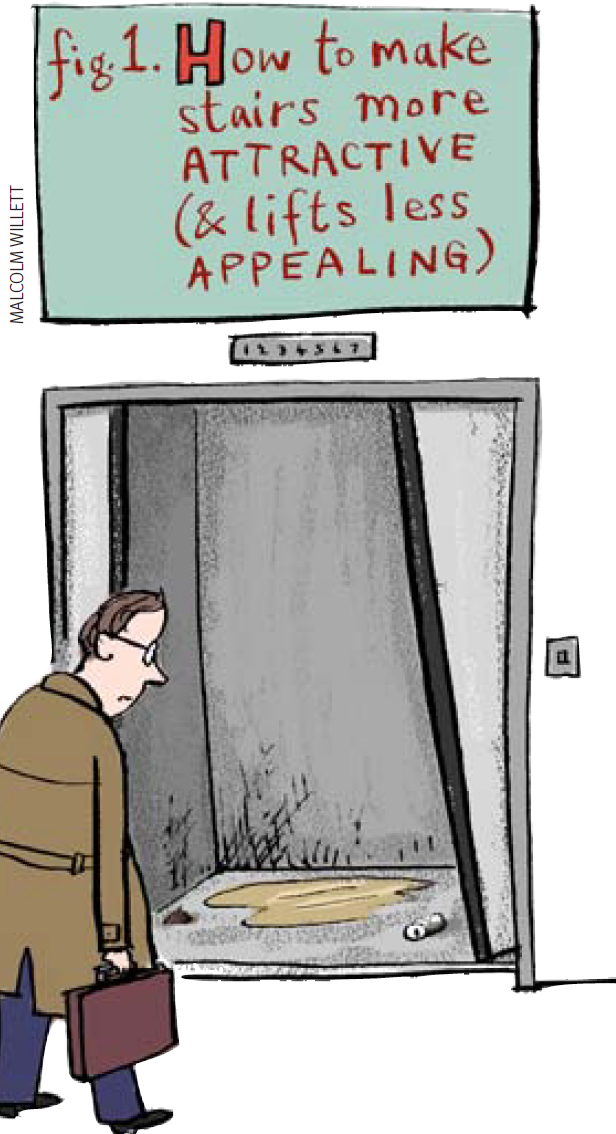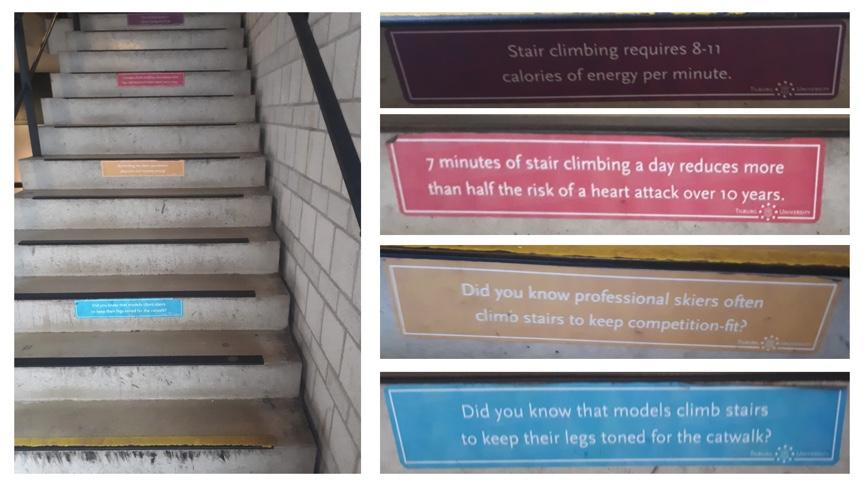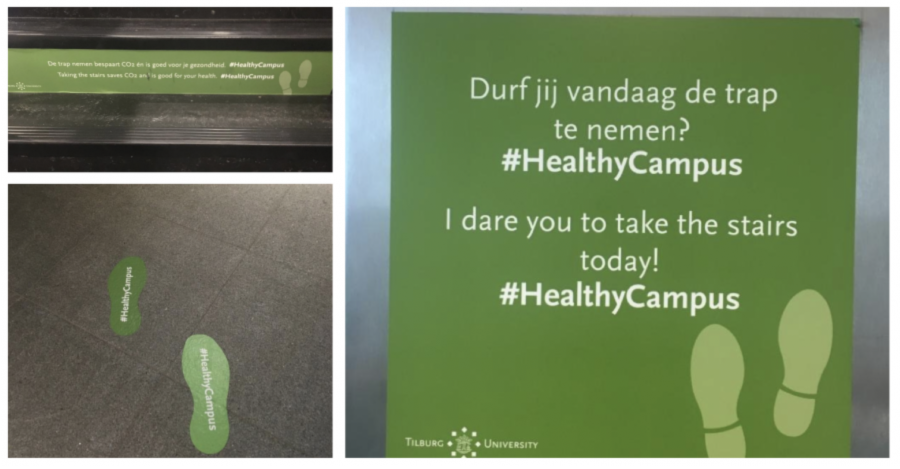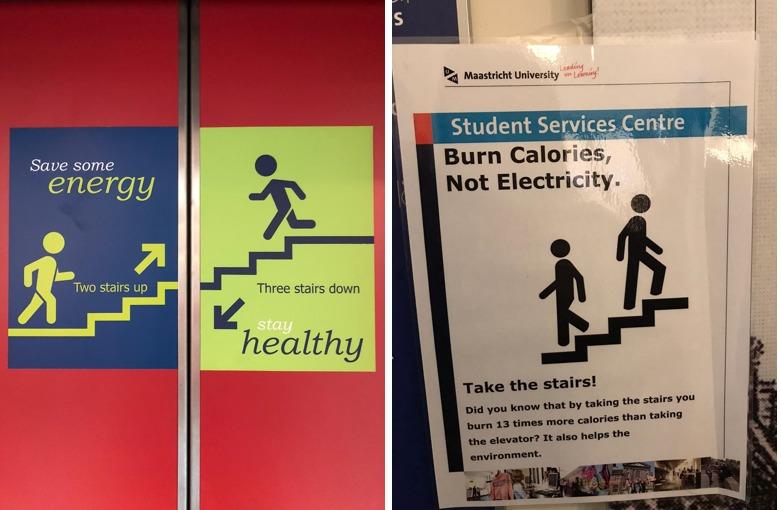
Nudging in the Healthy Direction
What is nudging? How is it practised in linguistic landscapes? The intended positive effect of nudging regarding a healthy lifestyle will be looked at in detail. This will be done by analyzing a specific case of nudging which is happening at Tilburg University.
Health nudging
Nudging has a long history and is increasingly practiced in public spaces by marketing organizations, but also by governmental institutions to stimulate positive behavior of people in a subconscious way. The goal of nudging is to motivate people to exhibit a certain type of behavior more and 'nudge' their behavior in a certain direction.
Nudging can involve changing the choice architecture with the goal to alter people's behavior without banning any options or requiring economic incentives (Hansen, 2016). The environmental intervention should be simple and easy to avoid. A nudge should be evidence-based and rely on scientific frameworks, theories and methodologies from behavioral economics but also from cognitive and social psychology (Hansen, 2016). As a practice, nudging tries to influence people's judgement. This judgement is often limited by cognitive boundaries and habits, creating barriers for people to make social decisions and perform rationally in their self-interest (Hansen, 2016)
Facts such as ''Did you know that models climb stairs to keep their legs toned for the catwalk?'' can be found all the way to the top of the stairs.
Nudging can be used in many different ways. For example, as a practice that is commonly used to increase the population's health. This can include: encouraging people to reduce smoking and alcoholic drinking habits, increasing healthy diets but also strengthening exercise habits (Roland, Kelly and Suhcke, 2011). Health nudging can be of great importance as most people do care about their health. However, they seem to persist in behaving in such a way that it is undermined (Roland et al., 2011). This can be a result of valuing other things over health. An example of health nudging to increase physical activity is making stairs, as opposed to elevators, increasingly attractive and prominent in public buildings (Roland et al., 2011).

Health nudging: making stairs more attractive and elevators less appealing
Nudging at Tilburg University
A few weeks ago, we, four students at Tilburg University, were on our way to class in the Warande Building on campus. Our attention was caught by health facts displayed on the stairs in order to promote physical exercise. Facts such as ''Did you know that models climb stairs to keep their legs toned for the catwalk?'' and ''7 minutes of stair climbing a day reduces more than half the risk of a heart attack over 10 years'' can be found all the way to the top of the staircase. The quotes are quite diverse. Messages about saving energy and thus, the environment, by not taking the elevator are displayed side by side quotes about the workouts of models and about calorie burning. Challenges like 'I dare you to take the stairs today' are placed on signs next to the elevator in order to stimulate the sense of competition and, therefore, the motivation to take the stairs

Stairs in Warande Building on Tilburg University Campus
This led us to wonder, what is the goal of these signs? Who created them? Why can they be found here? To find out more, we got into contact with two people who could provide us with this information and more. A communication employee and the vitality coordinator from the Sports Center of the university. After gathering the necessary information, the data is presented and analyzed in this article to create a deeper understanding of the topic of health nudging in the linguistic landscape of Tilburg University. It is important to point out that this specific linguistic landscaping analysis focuses solely on the case of Tilburg University. Other universities are only mentioned for comparison purposes. But before we begin , we need to have a look at where it all started.
The story behind every sign
From a sociolinguistic perspective, it is argued that every sign we encounter in daily life has a story. The story of a semiotic symbol reveals the purposes of the producer and who was selected by the producer as a target group. As Blommaert (2012) describes it: "Every sign points backwards to its origins and forward to its addressees". Every sign presupposes something and entails things when it is used or perceived. This can relate to both social and referential meanings, also known as indexicality.
To describe and take a deeper look into a sign in public space, the three arrows can be used, which are backwards, forwards and sideways arrows. The backwards arrow looks at the past, the person who made the sign, with what intentions and what were the conditions of production (Blommaert, 2012). The forwards arrow looks at the future: who are the addressees, what are conditions for uptake and what should be done with the sign. The third arrow is sideways, looking at the specific emplacement among other signs; why is the sign placed exactly there? These arrows can help to explain the indexicality of a sign (Blommaert, 2012). The interview with the producers of the stickers on the stairs of particular buildings at Tilburg University helped us to formulate the indexicality of this case.
The image of health
Public space is defined as a social, cultural and political entity that reflects certain policies and patterns of social behavior (Blommaert & Maly, 2014). As the signs on the stairs are placed within the Tilburg University campus, the messages are a reflection of the institution's policies and patterns of social behavior. Principally, the initiative was formulated from a HR perspective, with the aim of promoting a healthy work environment for the university's employees. Simultaneously, the fun facts on the stairs transmit the same message regarding the study environment for students. In other words, the signs reflect the university’s health policies for both employees, students and visitors as an utterance of a healthy image. It can be concluded that the signs aim to stimulate the desired behavior of people present on campus in line with the health policies and healthy image to which the university aspires.
Who is being nudged?
According to the communication employee and the vitality coordinator of Tilburg University, the signs on the steps are targeted at everyone who takes the stairs. Whoever walks is walking up the staircase can feel addressed by the signs. However, as mentioned above, the signs are funded by the HR department which cooperated with the Sports Centre of Tilburg University. They focused mainly on the well-being of the university's employees. These stickers are part of a campaign called '#HealthyCampus', which was initiated aimed at both employees and students of Tilburg University. All quotes are in Dutch and English due to the international character of Tilburg University. In this way, the biggest possible audience is guaranteed.
The interviewees mentioned that the signs on the stairs are for everyone who walk on the stairs. However, as we claimed above, public space is never neutral, and signs never address everyone. This could be the reason why the text is different on each sign. Some of these signs point out that taking the stairs is better for the environment, other signs point out that taking the stairs is better for personal health. In this way, people with different interests get addressed.
Besides being university lecturers, Tilburg University employees can strive to identify as active individuals who lead a healthy lifestyle.
On the other hands, next to the elevators around campus, continuously the same kind of texts are placed, namely: "I dare you to take the stairs today". This sign does not address everyone. For example: physically disabled people who use a wheelchair cannot take the stairs, even if they wanted to. These people are then excluded as addressees.
The signs on the stairs were part of the 'take the stairs week', in April 2019. The different quotes were put on the stairs in that week. Additionally, the university hired a motivator, who encouraged people to take the stairs with a song and a funny outfit. The #HealthyCampus campaign has several expressions, such as the movement bench in front of the Tias building and the smoke-free campus initiative. Creating a healthy image is not only targeted at the employees or students, but also at visitors of the university and potential new students and staff. Nowadays, it is increasingly important for employers to pay attention to vitality and the health of their employees, which was the main motivation behind this initiative.
In the contemporary society, people possess a repertoire of identities, meaning that we no longer identify ourselves and act according to one identity. Multiple identities co-exist in our daily lives. Besides being university lecturers for instance, Tilburg University employees can strive to identify as active individuals who lead a healthy lifestyle. So even at work, multiple identity options are provided by different organizations. This is in line with the current diverse society and our globalized behavioral patterns which were created due the improved economic conditions and the rise of the Internet.

Stairs in Simon building Tilburg University
Where's the nudge?
The signs are placed in three buildings on campus, the Warande, Simon and Tias building. Looking at the main target group of the signs, these buildings were chosen because besides students, a significant amount of the university employees is situated in these buildings. Besides that, the Simon and Tias buildings were recently renovated, which provided certainty that the signs could be placed there for a longer period of time. Furthermore, the healthy quotes are placed between the steps to make sure that one's attention is attracted to the text. If you are walking up the stairs, you see the signs between the steps, which can make people feel motivated about climbing up. Additionally, the signs are placed next to the elevators in the Simon and Tias building. The latter is done in order to stimulate people's choice to take the stairs rather than the elevator.
A nudging design
The design of signs has to match with the corporate identity of Tilburg University. Because the signs are part of a campaign by the university, most of the stickers are in the same style, as part of the above-mentioned identity of the university. The signs in the Warande building are displayed in different colors, such as blue, red, and green. Certain colors can trigger certain emotions, but overall, brighter and more saturated colors elevate greater pleasure, according to Valdez & Mehrabian (1994). In the Tias and Simon buildings, the signs are all the same color, green, which relates to the #HealthyCampus campaign. Moreover, all stickers display the Tilburg University logo, as part of the corporate identity.
Different sources confirm that nudging practices such as the ones happening at Tilburg University are effective. Specifically, research shows that footprints towards stairs are more effective than posters in order to encourage workers to take the stairs over the elevator (Mitchell, 2019). This supports the fact that nudging interventions that are creative, visual and engaging create positive effects (Mitchell, 2019). When looking at Tilburg University in particular, there are no numbers confirming that the signs motivate a higher number of people to take the stairs. The communication employee and vitality coordinator, however, have confidence that the goal has been reached. They both noticed more of their colleagues taking the stairs at work. Meanwhile, both positive and contradicting reactions have been heard from colleagues about the messages of the signs. Some people explained that they do not need a sign to tell them whether to take the stairs or not. They find the initiative patronizing.
Nudging in practice
In addition to the interview with the initiators of the signs, we conducted a small ethnographic enquiry about employees’ thoughts regarding the quotes on the stairs in the Simon building. This was done by implementing ethnographic linguistic landscaping. Ethnographic linguistic landscaping helps to take a closer look at sociolinguistics on a deeper level, by not only considering who made the signs, but also how it is used and how they are perceived (Blommaert & Maly, 2014).
We chose to only ask employees as this is the target group of the initiative. We first spoke to the caretaker of the building, who actively moves around the building on a daily basis. He informed us that he, as he uses the stairs frequently, does not always take the stairs up. However, he convinced us that he always walks down the stairs and that the majority of his colleagues do the same. Besides that, he mentioned that especially in the beginning, during the ‘take the stairs week’, many people paid attention to the quotes. During this ‘starting stage’ there was an increased visibility of awareness and motivation to take the stairs, amongst employees and students. All the other people who have been asked about their opinion regarding this topic agreed with this statement.
There has been an increased awareness about the harmful and lasting impact of burn out for employees and students.
It can be concluded that campaigns like this receive higher amounts of publicity due to their newness and different kinds of social/media support. Overall, all respondents agreed that they always take the stairs if they have to be on the first or second floor. Some of the lecturers mentioned that they read the fun facts in the beginning, but that they over time stopped paying attention to them. The quotes have become a normality. Finally, all the lecturers we talked to, agree on the fact that they already took the stairs frequently as a result of their own beliefs before the presence of the signs on the stairs. In that sense it can be concluded that this case of nudging at Tilburg University mostly hosts an entertaining value rather than an activating element. This is due to the loss of effect and value over time for people frequently exposed to the signs.
Healthy hype
The intervention to promote taking the stairs over taking the elevator is part of a bigger whole. The goal of the signs is to make people think about why they should take the stairs instead of the elevator in a fun way. Both employees and students suffer from an increasing pressure upon their work and future. Numerous initiatives are taken nowadays by different organizations to support a healthy lifestyle and (working) environment for employees, students and citizens. As stated in the previous section, there are already a few interventions Tilburg University implemented to improve a healthy lifestyle for everybody who walks on the campus.
Tilburg University is not only trying to promote a healthy campus by trying to let the students and employees exercise more. The University also wants to take care of mental health. They try to accomplish this through establishing mental health care facilities. Examples of this are student psychologists for students and confidentiality officers for students and employees.
The university also want to prevent absence due to burn out. This goes mainly for the employees, but also for the students. There has been an increased awareness about the harmful and lasting impact of burn out for employees and students. According to one of the interviewees, this is caused by the rising expectations for students. Nowadays, there are fewer financial resources for students to pay their tuition fees. In order to pay their tuition fees, a lot of students need to have a side job. There is also a limited amount of years wherein students have to graduate. "Only studying is not enough, at the same time students have to build their entire CV to be able to get a job after university" as was mentioned during the interview. This can cause a lot of stress, which in some cases, can even lead to burn out. Dworkin (1987) stated that burn out is not caused by low salaries. Burn outs are more likely caused by conflict and role ambiguity. This corresponds to what one of the interviewees said about students needing to live up to a lot of expectations.
Nudging at other universities
Tilburg University is not the only university trying to improve the lifestyle of all its visitors. There are also other universities trying to encourage a healthy lifestyle in all kinds of ways. We gathered some information about other universities on how they try to inspire a healthy lifestyle. We found out that the Universities of Delft and Maastricht also applied stickers on the elevators to promote taking the stairs. Pictures of this are displayed below.

Nudging at other universities
What also came forward during our interviews is that healthy nudging is a general trend these days. It can be found in all types of organizations: banking organizations, hospitals, catering industries and so on. "As a university, we naturally want to contribute to this hype", as was mentioned during the interview. Especially "because this organization does not only have employees, it also has students.
The future of nudging
The trend of paying attention to health in the context of being an employer is clearly on the rise. The signs on the stairs in the buildings on Tilburg University campus are an example of bringing this into practice. But this intervention can be developed more over time. According to some people who have been interviewed about the health nudging on campus stairs, the intervention loses its effect over time. When something is new, people will notice it actively. A good idea can be to add some new elements from time to time, to keep it new and interesting. Besides that, for example, the signs can be placed in more buildings, to reach more people. Or the facts presented on the signs can be rewritten, because at the moment, they are not substantiated with any theory.
Healthy nudging is a general trend these days: "As a university, we naturally want to contribute to this hype.".
According to the vitality coordinator, the target group of the signs is everyone who walks on the stairs, employees, students and visitors. However, the signs are targeted at the employees of the university. The location of the signs was targeted in the buildings where employees have their offices. To improve the operation of the signs, they can also be placed in buildings where a lot of students take the stairs, because in the end they are also part of the target group. Hence, looking at the three arrows, the signs can be improved in several ways.
With the trend of health all around us, we are constantly nudged to make certain decisions. It is therefore becoming increasingly important for employers to consider best nudging practices to create a healthy environment for everyone.
References
Blommaert, J. (2012). Chronicles of complexity Ethnography, Superdiversity, and Linguistic Landscapes. Tilburg Papers in Culture Studies. Tilburg: Tilburg University.
Blommaert, J. & Maly, I., (2014). Ethnographic Linguistic Landscape Analysis and Social Change: A Case Study. Tilburg Papers in Culture Studies. Tilburg: Tilburg University.
Dworkin, A. G. (1987). Teacher Burnout in the Public Schools: Structural Causes and Consequences for Children. United States of America: State University of New York Press.
Hansen, P.G. (2016, August 16). What is nudging? Behavioural Science & Policy Association.
Mitchell, J. (2019, October 2). Theories, Nudges and Personality - How to Influence Behaviour. LinkedIn.
Roland, M., Kelly, M.P., Suhrucke, M., (2011). Judging Nudging: Can Nudging Improve Population Health? BJM (online), 343(1), pp. 263-265.
Valdez, P., & Mehrabian, A. (1994). Effects of Color on Emotions. Journal of Experimental Psychology: General, 123(4), 394–409.